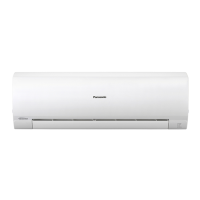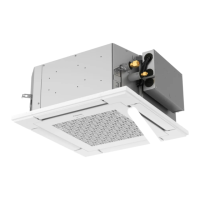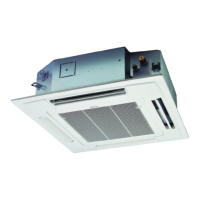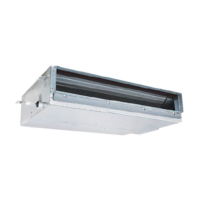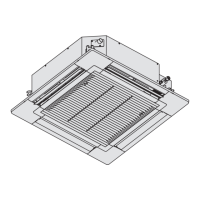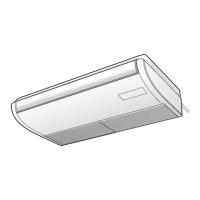v
(3) If an indoor unit is installed in each partitioned room and
the refrigerant tubing is interconnected, the smallest room
of course becomes the object. But when mechanical
ventilation is installed interlocked with a gas leakage
detector in the smallest room where the density limit is
exceeded, the volume of the next smallest room becomes
the object.
2. The minimum indoor floor space compared with the
amount of refrigerant is roughly as follows: (When the
ceiling is 2.7 m high)
20100 30 40 60 70 80 90 10050
m
2
m
3
40.5
54.0
27.0
13.5
0.0
67.5
81.0
94.5
108.0
121.5
135.0
148.5
162.0
175.5
189.0
202.5
216.0
15
10
5
0
20
25
30
35
40
45
50
55
60
65
70
75
80
229.5
85
kg
Total amount of refrigerant
Range below the
density limit of
0.44 kg/m³
(Countermeasures
not needed)
Range above the
density limit of
0.44 kg/m³
(Countermeasures
needed)
Min. indoor volume
Min. indoor floor area
(when the ceiling is 2.7 m high)
Check of Density Limit
Check the amount of refrigerant in the system and
floor space of the room according to the legislation on
refrigerant drainage. If there is no applicable legislation,
follow the standards described below.
The room in which the air conditioner is to be installed
requires a design that in the event of refrigerant gas
leaking out, its density will not exceed a set limit.
The refrigerant (R410A), which is used in the air conditioner,
is safe, without the toxicity or combustibility of ammonia, and
is not restricted by laws imposed to protect the ozone layer.
However, since it contains more than air, it poses the risk of
suffocation if its density should rise excessively. Suffocation
from leakage of refrigerant is almost non-existent. With the
recent increase in the number of high density buildings,
however, the installation of multi air conditioner systems is
on the increase because of the need for effective use of floor
space, individual control, energy conservation by curtailing heat
and carrying power, etc.
Most importantly, the multi air conditioner system is able
to replenish a large amount of refrigerant compared to
conventional individual air conditioners. If a single unit of the
multi air conditioner system is to be installed in a small room,
select a suitable model and installation procedure so that if the
refrigerant accidentally leaks out, its density does not reach the
limit (and in the event of an emergency, measures can be made
before injury can occur).
In a room where the density may exceed the limit, create an
opening with adjacent rooms, or install mechanical ventilation
combined with a gas leak detection device. The density is as
given below.
Total amount of refrigerant (kg)
Min. volume of the indoor unit installed room (m
3
)
< Density limit (kg/m
3
)
The density limit of refrigerant which is used in multi air
conditioners is 0.44 kg/m
3
(ISO 5149).
NOTE
1. The standards for minimum room volume are as follows.
(1) No partition (shaded portion)
(2) When there is an effective opening with the adjacent room
for ventilation of leaking refrigerant gas (opening without
a door, or an opening 0.15% or larger than the respective
floor spaces at the top or bottom of the door).
Outdoor unit
Refrigerant tubing
Indoor unit
Mechanical ventilation device – Gas leak detector
Refrigerant tubing
Outdoor unit
Indoor unit
Very
small
room
Small
room
Medium
room
Large room
00_291827_2WAY_Eng.indb 5 2017/7/5 13:41:24
Precautions for Installation Using New Refrigerant
1. Care regarding tubing
1-1. Process tubing
● Material: Use seamless phosphorous deoxidized copper tube for refrigeration. Wall thickness shall comply with the applicable
legislation. The minimal wall thickness must be in accordance with the table below.
● Tubing size: Be sure to use the sizes indicated in the table below.
For the renewal tubing size, refer to the Technical Data.
● Use a tube cutter when cutting the tubing, and be sure to remove any flash. This also applies to distribution joints (optional).
● When bending tubing, use a bending radius that is 4 times the outer diameter of the tubing or larger.
CAUTION
Use sufficient care in handling the tubing. Seal the tubing ends with caps or tape to prevent dirt,
moisture, or other foreign substances from entering. These substances can result in system
malfunction.
Unit: mm
Material Temper - O (Soft copper tube)
Copper tube
Outer diameter 6.35 9.52 12.7 15.88 19.05
Wall thickness 0.8 0.8 0.8 1.0 1.2
1-2. Prevent impurities including water, dust and oxide from entering the tubing. Impurities can cause R410A refrigerant deterioration
and compressor defects. Due to the features of the refrigerant and refrigerating machine oil, the prevention of water and other
impurities becomes more important than ever.
2. Be sure to recharge the refrigerant only in liquid form.
2-1. Since R410A is a non-azeotrope, recharging the refrigerant in gas form can lower performance and cause defects in the unit.
2-2. Since refrigerant composition changes and performance decreases when gas leaks, collect the remaining refrigerant and recharge
the required total amount of new refrigerant after fixing the leak.
3. Different tools required
3-1. Tool specifications have been changed due to the characteristics of R410A.
Some tools for R22- and R407C-type refrigerant systems cannot be used.
Item New tool?
R407C tools
compatible
with R410A?
Remarks
Manifold gauge
Manifold gauge Yes No Types of refrigerant, refrigerating machine oil,
and pressure gauge are different.
Charge hose Yes No To resist higher pressure, material must be
changed.
Vacuum pump Yes Yes Use a conventional vacuum pump if it is equipped
with a check valve. If it has no check valve,
purchase and attach a vacuum pump adapter.
Leak detector Yes No Leak detectors for CFC and HCFC that react to
chlorine do not function because R410A contains
no chlorine. Leak detectors for HFC134a can be
used for R410A.
Vacuum pump
Outlet
Inlet
Flaring oil Yes No For systems that use R22, apply mineral oil
(Suniso oil) to the flare nuts on the tubing to
prevent refrigerant leakage. For machines that
use R407C or R410A, apply synthetic oil (ether
oil) to the flare nuts.
* Using tools for R22 and R407C and new tools for R410A together can cause defects.
3-2. Use R410A exclusive cylinder only.
Single-outlet valve
(with siphon tube)
Liquid refrigerant should be
recharged with the cylinder
standing on end as shown.
Valve
Liquid
00_291827_2WAY_Eng.indb 6 2017/7/5 13:41:24
SM830258-01_欧州向け_1fan_mini_VRF.indb 6 18/03/02 10:16:59
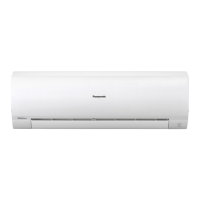
